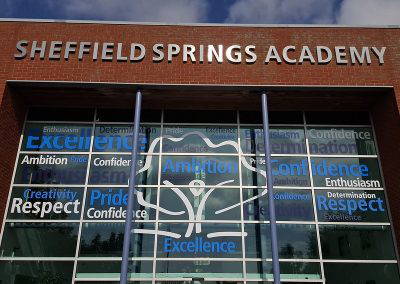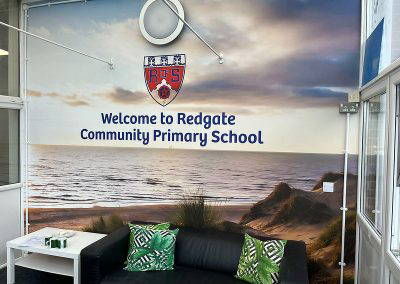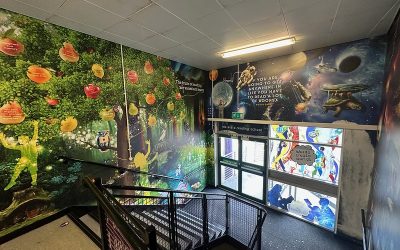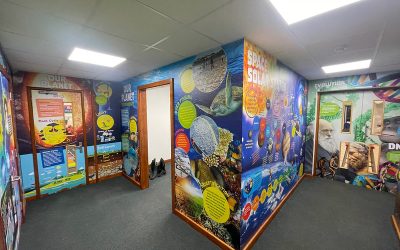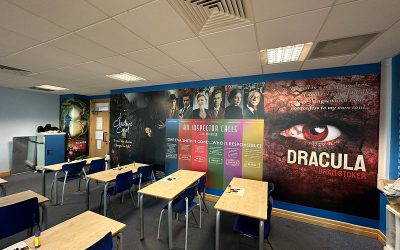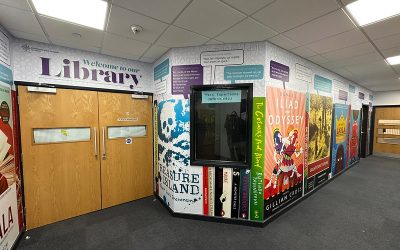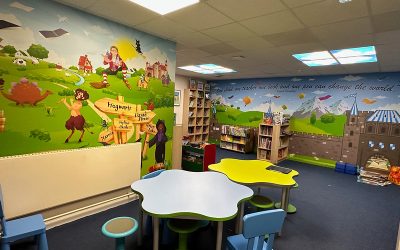Imagine your school with every wall telling a story. Vibrant murals depicting historical events. Colourful graphics explaining scientific concepts. Artistic representations that celebrate your school’s values and cultural diversity.
Tap into the benefits of wall art for schools; they do more than simply decorate – they have the power to transform your school into a more engaging, inspiring place for learning and growth. Whether it’s a motivational quote in a hallway or a world map in a geography classroom, thoughtfully designed wall art can make a lasting impression on students, staff, and visitors.
If you’re thinking about using transformative school wall art, the first step is to take your school wall art ideas and craft an effective school wall art design brief. This will guide the creative process, ensuring that the final product aligns with your school’s vision, educational objectives, and budget constraints.
We’ve authored this article to help guide you through the process of composing a design brief for classroom wall displays. From setting educational goals and defining aesthetic preferences, to managing budgets and collaborating with artists, this article covers everything you need to know to turn your school’s walls into powerful educational tools.
Step 1: Understand the Purpose of Wall Art for Schools
When conceptualising your school wall art ideas, it’s essential to identify and qualify its purpose. This understanding will guide the design process and also ensure that your design brief helps to create classroom wall displays that serve your school’s broader educational and cultural goals. Here are five key purposes to consider:
1. Educational Objectives
One of the primary purposes of school wall art is to support educational goals. Art can be a powerful tool for inspiring creativity, promoting your school’s values and mission, and encouraging enthusiasm and curiosity that spark the motivation for learning.
2. Promoting School Values
Wall art can visually reinforce the core values and principles of the school, such as respect, inclusivity, and perseverance. This could be through quotes, symbolic imagery, or scenes that embody these values.
3. Enhancing Subject Matter Understanding
Well-designed artwork can aid in the comprehension of academic subjects. For instance, a detailed mural depicting key writers and events throughout the history of English Literature can help bring a challenging subject to life. Other school wall art ideas include depictions of the diversity of world cultures, world geographies, and the science behind the universe.
4. Enhancing Your School’s Aesthetics
Beyond educational functions, wall art plays a crucial role in enhancing the visual appeal of school environments. Aesthetically pleasing spaces can turn dull spaces alive into inspiring areas that stimulate students. Don’t neglect the use of colours and imagery and the impact they can have on mood – calm blues and greens can create a soothing atmosphere conducive to concentration and learning, while bright, bold colours can energize and motivate.
5. Cementing the School Community
School wall art also offers an opportunity to reflect and celebrate the diversity and culture of your school community. This helps students from diverse backgrounds to feel part of something bigger, and to feel represented and valued at an individual level, too. For example, a mural featuring global landmarks or traditional art styles from around the world can be both educational and affirming.
Step 2: Make These Key Considerations
With your purpose identified, you can move onto the next step of considering your budget, the project’s scale, and design preferences:
· Budget Planning
Your budget will influence many aspects of the project, from the size and complexity of the artwork to the materials used.
Start by assessing the available funds and setting a realistic budget. Consider factors such as the size of the wall or area to be covered, the type of materials (paint, vinyl, mixed media), and the complexity of the design. Intricate and large-scale murals will generally require a higher budget due to the time and resources involved.
To manage costs effectively, explore various funding sources. This can include contributions from the Parent-Teacher Association (PTA), grants from educational or arts organisations, and school fundraising events.
· Scope and Scale
Defining the scope and scale of the project is essential for creating a clear and focused design brief. You’ll need to determine and prioritise which areas of the school are to feature wall displays. This might include locations like entryways and hallways, to specific spaces like classrooms, libraries, and communal areas.
Don’t limit your plans to the interior; outdoor walls can also be excellent and can be used to create welcoming, engaging environments that are visible to the broader community, enhancing the school’s public image.
· Design Preferences and Specifications
Decide on the overall style you wish to pursue. Abstract designs might be used for inspirational and thought-provoking murals, while realistic art can effectively illustrate specific educational themes. Of course, you’ll also need to consider incorporating the school’s colours and branding elements to foster a sense of identity and unity. You might include the school logo, mascot, or motto, subtly integrated into the artwork.
Finally, ensure that the design is inclusive and appropriate for all age groups within the school, considering the emotional and psychological impact of the artwork on different age groups, ensuring it is both inspiring and comforting.
Step 3: Collaboration and Stakeholder Engagement
Involve various members of the school community to ensure that the final product is not only visually appealing but also meaningful and resonant with the school’s identity and values.
By involving students, teachers, and parents in the design process, you’ll develop a sense of ownership and pride in the project. You might organise sessions in which students get to put forward their ideas. Students might also contribute their own artwork – involvement that can be particularly meaningful and educational.
Before starting on this part of the process, you should form an advisory committee that can provide ongoing feedback as well as ensuring the project stays on track with its purpose and key considerations.
Step 4: Craft a Detailed Wall Art Brief
Now we come to creating the wall art brief itself. This is a document that serves as a comprehensive guide for artists and designers, outlining the scope, objectives, and logistical considerations of the project. Here’s how to craft an effective brief:
· Provide Background Information
Give your wall art project context to help artists and designers understand your objectives and your school environment:
- Include basic information about the school, such as its size and demographics. Highlight any unique aspects, such as the school’s focus on specific educational programs or its cultural diversity.
- Mention any existing art within the school, noting how the new project should complement or expand upon the current aesthetic.
You should also communicate the vision for your wall displays – such as the message of feeling you wish to convey, and the impact you wish the wall art to have on students, staff, and visitors.
· Deliver Your Artistic and Educational Vision
Drive the creative direction by identifying key themes or subjects you want the artwork to explore. These could include academic topics, cultural diversity, environmental awareness, or historical events.
You should also describe the style and tone of the art, such as whether it should be abstract, realistic, playful, or inspirational, and explain how the wall displays will be used. We’re experiencing a surge in requests for visual aids that complement the school curriculum, and the popularity of including QR codes that link to additional resources and interactive elements continues to grow.
· Be Mindful of Technical and Logistical Details
Addressing practical considerations ensures that the project is feasible and sustainable. You’ll need to provide details about the installation site, including wall surface types (e.g., brick, plaster), lighting conditions, and any other environmental factors. Consider, too, if there are any other potential challenges, such as high-traffic areas or limited accessibility, and suggest solutions or workarounds.
Don’t neglect the question of maintenance and durability of materials used. This is particularly relevant for high-contact areas as well as walls that are exposed to the force of nature. You should seek advice on how the wall art is to be cared for to stand the test of time.
· Timeline and Milestones
Establish a realistic timeline for the project, from initial phase through to installation. You’ll need to consider school schedules and holidays, and create a timetable of events with milestones that include:
- Design approval
- Production of artwork
- Installation
Tips for Collaborating with Artists and Designers
As you take your school wall art ideas from the drawing board to installation, you’ll need to collaborate with professional artists and designers. Of course, the wall art brief is crucial, but so too is effective communication.
· Clarify Roles and Responsibilities
A good working relationship depends upon everyone knowing and understanding their roles and responsibilities. Though we’re discussing how you collaborate with artists and designers, this does, of course, apply to other project stakeholders such as school staff, administrators, and others.
Key to this is that you ensure that all documents, timelines, budgets, and deliverables are disseminated to and understood by all stakeholders. This will help to prevent misunderstandings and keep everyone on the same page.
· Keep the Lines of Communication Open
Regular meetings and progress updates will give you a forum to address any concerns as well as adjust if needed. Such ongoing dialogue will help keep your project on track.
It’s also important to provide constructive feedback. When doing so, be clear and concise – vague comments will only lead to confusion. Instead, focus on specific and actionable suggestions, highlighting which aspects you like most and changes you feel are needed.
· Respect the Artist’s Expertise and Process
Leave room for the artist’s creativity. You’ll benefit from their experience and expertise, and their knowledge and work on similar projects, so a little flexibility will help to deliver an inspirational and unique product.
It can be challenging to allow a degree of flexibility, but it is crucial to trust professional judgement. It’s an iterative process, and one that often leads to innovative and improved outcomes as ideas evolve and benefit from artistic techniques, material choices, and visual storytelling.
How Do You Select the Best Design Firm for Your School Wall Art?
The partner you choose is crucial to the success of your school wall art project. Here are key steps to find the ideal design firm:
· Research Potential Firms
Look for firms with experience in creating art for educational settings. This experience ensures that they understand the unique considerations of working in a school environment, such as creating age-appropriate content and integrating educational themes.
· Portfolio Review
Review the portfolios of potential firms to assess their style and versatility. Check for diversity in their work and whether they have experience with similar projects in terms of scale and complexity. If possible, visit sites of past projects to see the firm’s work first-hand. This can give you a better sense of the scale, detail, and impact of their art in a real-world setting.
· Request Proposals and Preliminary Concepts
· Evaluate Communication and Collaboration Skills
Pay attention to how well the firms communicate during the initial stages. Clear, responsive communication is crucial for a successful partnership. Ask about their process for involving clients in the creative process. A good firm will welcome collaboration and feedback, ensuring the final design meets your expectations.
· Finalise Your Selection
Once you’ve chosen a firm, formalise the agreement with a detailed contract. This should outline all aspects of the project, including timelines, budgets, deliverables, and the process for revisions.
How Can Design for Education Help Your School?
We’ve helped schools of all types and sizes transform corridors, reception areas, staircases, and classrooms into exciting and engaging learning spaces. We base our designs around your school’s needs – and there is no limit to what we can accomplish together, given your design brief and our artistic experience in school settings.
When we have completed the artistic process to your satisfaction, our highly skilled installation team will ensure that your wall display not only looks stunning but will also stand the test of time.
Begin the process today. Contact Design for Education to request a call to discuss your project
More like this…
School Wall Displays: Engaging Students Beyond the Classroom
Unlock the Hidden Power of Your Educational Environment School wall displays are a powerful yet often underutilised tool in education. The power of well-designed, vibrant school wall murals goes far beyond improving the aesthetics of a school. They become an extension...
School Walls as Learning Tools: Engaging Displays for Every Subject
Reimagining School Walls for Dynamic Education In the modern education environment, using school walls as learning tools helps teaching staff to go beyond textbooks and digital screens. Indeed, they are proving to be an integral visual learning tool, with research...
How School Wall Displays Inspire Your Students
The walls of a classroom do more than just enclose a space, they also shape your students learning environment. Thoughtfully designed school wall displays can ignite curiosity, celebrate achievements, and reinforce key concepts, making learning more engaging. Whether showcasing student work, visualising complex ideas, or creating an inspiring atmosphere, well-crafted displays encourage participation as well as motivation. The right visuals can transform your classroom into a dynamic, stimulating space that supports both academic success and personal growth.
Transforming School Walls: Inspiring Educational Spaces with Custom Wall Art
Transforming school walls with custom wall art can create inspiring educational spaces that foster creativity, motivation, and engagement among students. By incorporating vibrant designs that reflect a school’s values and curriculum, such as historical timelines or scientific concepts, educators can enhance learning environments and reinforce school identity. Thoughtfully designed wall art not only creates engaging spaces but also serves as an educational tool, turning blank walls into sources of inspiration.
Using Wall Art in School Libraries to Foster a Love for Reading
Creating Dynamic Reading Spaces with Murals and Interactive Displays Employing wall art in your school library is a wonderful way to create a vibrant, inviting atmosphere that encourages students to read more. From literary-themed murals to interactive graphics,...
10 Creative Wall Art Ideas for Primary Schools
Looking to brighten up your primary school’s walls? Our team have assembled 10 creative wall art ideas for primary schools which can transform dull spaces into vibrant, educational canvases. From murals that promote core values and inspire growth mindsets to interactive literacy and numeracy walls, these designs bring learning to life. Celebrate diversity, showcase history, or create themed learning corners – each idea fosters a welcoming environment and supports students’ development. Whether indoors or outdoors, school wall art is a powerful tool to reflect your school’s ethos, enhance engagement, and inspire creativity.

